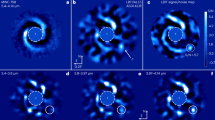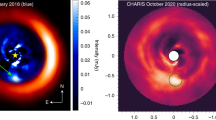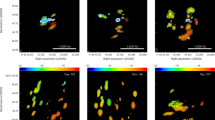Abstract
Newly forming protoplanets are expected to create cavities and substructures in young, gas-rich protoplanetary disks1,2,3, but they are difficult to detect as they could be confused with disk features affected by advanced image analysis techniques4,5. Recently, a planet was discovered inside the gap of the transitional disk of the T Tauri star PDS 706,7. Here, we report on the detection of strong Hα emission from two distinct locations in the PDS 70 system, one corresponding to the previously discovered planet PDS 70 b, which confirms the earlier Hα detection8, and another located close to the outer edge of the gap, coinciding with a previously identified bright dust spot in the disk and with a small opening in a ring of molecular emission6,7,9. We identify this second Hα peak as a second protoplanet in the PDS 70 system. The Hα emission spectra of both protoplanets indicate ongoing accretion onto the protoplanets10,11, which appear to be near a 2:1 mean motion resonance. Our observations show that adaptive-optics-assisted, medium-resolution integral field spectroscopy with MUSE12 targeting accretion signatures will be a powerful way to trace ongoing planet formation in transitional disks at different stages of their evolution. Finding more young planetary systems in mean motion resonance would give credibility to the Grand Tack hypothesis in which Jupiter and Saturn migrated in a resonance orbit during the early formation period of our Solar System13.
This is a preview of subscription content, access via your institution
Access options
Access Nature and 54 other Nature Portfolio journals
Get Nature+, our best-value online-access subscription
$29.99 / 30 days
cancel any time
Subscribe to this journal
Receive 12 digital issues and online access to articles
$119.00 per year
only $9.92 per issue
Buy this article
- Purchase on Springer Link
- Instant access to full article PDF
Prices may be subject to local taxes which are calculated during checkout



Similar content being viewed by others
Data availability
The data used in this work are publicly available on the ESO archive (http://archive.eso.org/) under programmes 60.A-9100(K), 095.C-0298(A), 097.C-0206(A) and 097.C-1001(A).
References
Kley, W. & Nelson, R. P. Planet-disk interaction and orbital evolution. Annu. Rev. Astron. Astrophys. 50, 211–249 (2012).
Zhu, Z., Nelson, R. P., Hartmann, L., Espaillat, C. & Calvet, N. Transitional and pre-transitional disks: gap opening by multiple planets? Astrophys. J. 729, 47 (2011).
Dodson-Robinson, S. E. & Salyk, C. Transitional disks as signposts of young, multiplanet systems. Astrophys. J. 738, 131 (2011).
Rameau, J. et al. An optical/near-infrared investigation of HD 100546 b with the gemini planet imager and MagAO. Astrophys. J. 153, 224 (2017).
Huélamo, N. et al. Searching for Hα emitting sources around MWC 758. SPHERE/ZIMPOL high-contrast imaging. Astron. Astrophys. 613, L5 (2018).
Keppler, M. et al. Discovery of a planetary-mass companion within the gap of the transition disk around PDS 70. Astron. Astrophys. 617, A44 (2018).
Müller, A. et al. Orbital and atmospheric characterization of the planet within the gap of the PDS 70 transition disk. Astron. Astrophys. 617, L2 (2018).
Wagner, L. et al. Magellan adaptive optics imaging of PDS 70: measuring the mass accretion rate of a young giant planet within a gapped disk. Astrophys. J. 863, L8 (2018).
Long, Z. C. et al. Differences in the gas and dust distribution in the transitional disk of a Sun-like young star, PDS 70. Astrophys. J. 858, 112 (2018).
Natta, A. et al. Accretion in brown dwarfs: an infrared view. Astron. Astrophys. 424, 603–612 (2004).
Rigliaco, E. et al. X-shooter spectroscopy of young stellar objects. I. Mass accretion rates of low-mass T Tauri stars in σ Orionis. Astron. Astrophys. 548, A56 (2012).
Bacon, R. et al. The MUSE second-generation VLT instrument. Proc. SPIE 7735, 773508 (2010).
Walsh, K. et al. A low mass for Mars from Jupiter’s early gas-driven migration. Nature 475, 206–209 (2011).
Gaia Collaboration The Gaia mission. Astron. Astrophys. 595, A1 (2016).
Gaia Collaboration Gaia data release 2. Summary of the contents and survey properties. Astron. Astrophys. 616, A1 (2018).
Gregorio-Hetem, J. & Hetem, A. Classification of a selected sample of weak T Tauri stars. Mon. Not. R. Astron. Soc. 336, 197–206 (2002).
Hashimoto, J. et al. Polarimetric imaging of large cavity structures in the pre-transitional protoplanetary disk around PDS 70: observations of the disk. Astrophys. J. 758, L19 (2012).
Hashimoto, J. et al. The structure of pre-transitional protoplanetary disks. II. Azimuthal asymmetries, different radial distributions of large and small dust grains in PDS 70. Astrophys. J. 799, 43 (2015).
Pinilla, P. et al. Trapping dust particles in the outer regions of protoplanetary disks. Astron. Astrophys. 538, A114 (2012).
Pinilla, P., Benisty, M. & Birnstiel, T. Ring shaped dust accumulation in transition disks. Astron. Astrophys. 545, A81 (2013).
Edwards, S., Hartigan, P., Ghandour, L. & Andrulis, C. Spectroscopic evidence for magnetospheric accretion in classical T Tauri stars. Astrophys. J. 108, 1056 (1994).
Reipurth, B., Pedrosa, A. & Lago, M. T. V. T. Hα emission in pre-main sequence stars. I. An atlas of line profiles. Astron. Astrophys. Suppl. 120, 229–256 (1996).
Armitage, P. J., Livio, M. & Pringle, J. E. Episodic accretion in magnetically layered protoplanetary discs. Mon. Not. R. Astron. Soc. 324, 705–711 (2001).
Xu, W., Lai, D. & Morbidelli, A. Migration of planets into and out of mean motion resonances in protoplanetary discs: overstability of capture and non-linear eccentricity damping. Mon. Not. R. Astron. Soc. 481, 1538–1549 (2018).
Nelson, R. P., Papaloizou, J. C. B., Masset, F. & Kley, W. The migration and growth of protoplanets in protostellar discs. Mon. Not. R. Astron. Soc. 318, 18–36 (2000).
Kley, W., Peitz, J. & Bryden, G. Evolution of planetary systems in resonance. Astron. Astrophys. 414, 735–747 (2004).
Oberti, S. et al. AOF LTAO mode: reconstruction strategy and first test results. Proc. SPIE 9909, 99091 (2016).
Madec, P. Y. et al. Adaptive optics facility: from an amazing present to a brilliant future. Proc. SPIE 10703, 1070302 (2018).
Weilbacher, P. M. et al. The MUSE data reduction pipeline: status after preliminary acceptance Europe. Proc. Astron. Data Anal. Softw. Syst. XXIII 485, 451 (2014).
Hoeijmakers, H. J. et al. Medium-resolution integral-field spectroscopy for high-contrast exoplanet imaging. Molecule maps of the β Pictoris system with SINFONI. Astron. Astrophys. 617, A114 (2018).
Pueyo, L. Detection and characterization of exoplanets using projections on Karhunen Loeve eigenimages: forward modeling. Astrophys. J. 824, 117 (2016).
Foreman-Mackey, D., Hogg, D. W., Lang, D. & Goodman, J. emcee: the MCMC hammer. Publ. Astron. Soc. Pac. 125, 306 (2013).
Vigan, A. et al. Photometric characterization of exoplanets using angular and spectral differential imaging. Mon. Not. R. Astron. Soc. 407, 71–82 (2010).
Stolker, T. et al. PynPoint: a modular pipeline architecture for processing and analysis of high-contrast imaging data. Astron. Astrophys. 621, A59 (2019).
Hunziker, S., Quanz, S. P., Amara, A. & Meyer, M. R. PCA-based approach for subtracting thermal background emission in high-contrast imaging data. Astron. Astrophys. 611, A23 (2018).
Marois, C., Lafreniere, D., Doyon, R., Macintosh, B. & Nadeau, D. Angular differential imaging: a powerful high-contrast imaging technique. Astrophys. J. 641, 556–564 (2006).
Amara, A. & Quanz, S. P. PYNPOINT: an image processing package for finding exoplanets. Mon. Not. R. Astron. Soc. 427, 948–955 (2012).
Soummer, R. Apodized pupil Lyot coronagraphs for arbitrary telescope apertures. Astrophys. J. Lett. 618, L161–L164 (2004).
Choquet, É. et al. Archival legacy investigations of circumstellar environments: overview and first results. Proc. SPIE 9143, 914357 (2014).
Smith, B. A. & Terrile, R. J. A circumstellar disk around β Pictoris. Science 226, 1421–1424 (1984).
Allard, F. et al. The limiting effects of dust in brown dwarf model atmospheres. Astrophys. J. 556, 357–372 (2001).
Acknowledgements
This work is based on observations collected at the European Organisation for Astronomical Research in the Southern Hemisphere under ESO programmes 60.A-9100(K), 095.C-0298(A), 097.C-0206(A) and 097.C-1001(A). A.J.B. and J.d.B. acknowledge support from the European Research Council (ERC) Starting Grant 678194 (FALCONER). I.A.G.S. acknowledges funding from the ERC under the European Union’s Horizon 2020 research and innovation programme under grant agreement no. 694513. R.B. acknowledges support from the ERC advanced grant 339659-MUSICOS. J.B. acknowledges support by FCT/MCTES through national funds by the grant UID/FIS/04434/2019 and through the Investigador FCT contract no. IF/01654/2014/CP1215/CT0003. The authors acknowledge the ESO AOF and Paranal teams for their expertise and support during the commissioning activities.
Author information
Authors and Affiliations
Contributions
This work made use of the newly commissioned narrow-field mode of MUSE on the VLT that was led by R.B. S.Y.H., J.d.B., J.H.G. and J.B. prepared the observations, which were executed by R.B. and J.B. J.B. reduced the raw data products from MUSE with the ESO MUSE pipeline. S.Y.H. wrote the HRSDI pipeline, processed and analysed the combined data cubes, and performed the astrometry and orbit fitting. A.J.B. reduced the archival SPHERE and NACO data, performed the photometry and astrometry on these datasets and wrote the corresponding sections. I.A.G.S. and C.U.K. supervised the effort of S.Y.H. All authors contributed to key aspects of the manuscript.
Corresponding author
Ethics declarations
Competing interests
The authors declare no competing interests.
Additional information
Publisher’s note: Springer Nature remains neutral with regard to jurisdictional claims in published maps and institutional affiliations.
Supplementary information
Rights and permissions
About this article
Cite this article
Haffert, S.Y., Bohn, A.J., de Boer, J. et al. Two accreting protoplanets around the young star PDS 70. Nat Astron 3, 749–754 (2019). https://doi.org/10.1038/s41550-019-0780-5
Received:
Accepted:
Published:
Issue Date:
DOI: https://doi.org/10.1038/s41550-019-0780-5
This article is cited by
-
Free-floating binary planets from ejections during close stellar encounters
Nature Astronomy (2024)
-
Herbig Stars
Space Science Reviews (2023)
-
Water in the terrestrial planet-forming zone of the PDS 70 disk
Nature (2023)
-
A massive gas giant caught in formation
Nature Astronomy (2022)
-
Images of embedded Jovian planet formation at a wide separation around AB Aurigae
Nature Astronomy (2022)



